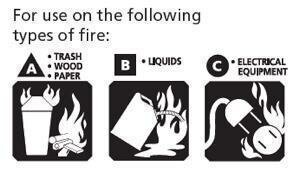Fire extinguishers can help to put out small fires, but should not be relied on to put out fires that have already become large.
Most home fires begin in the kitchen, so I recommend maintaining a larger capacity fire extinguisher there. The workshop or garage is another good location for a larger capacity extinguisher. In addition, there should be at least one larger extinguisher on every floor of your house. In the US, these larger extinguishers might be labeled 2-A:10-B:C. Smaller capacity fire extinguishers can be maintained in other rooms to ensure that you are never more than forty feet from a working fire extinguisher.
It is important that everyone in the family know where the fire extinguishers are and how to use them in an emergency.Family members should be able to find and operate your fire extinguishers in the dark. Emptying a fire extinguisher is a recom mended training practice for making family members comfortable with using extinguishers.
mended training practice for making family members comfortable with using extinguishers.
You should recharge or (preferably) replace fire extinguishers on a regular basis. I recommend replacing all fire extinguishers every six years. The old ones can be used for training before discarding. In addition, you must check the pressure indicators on each fire extinguisher at least once a year.
Fire Extinguisher Ratings
Fire extinguishers are rated by their capacity and by the type of fires they are designed to combat. These type ratings are not standard across the globe, so you have to know which standard your extinguishers comply with. Here are some of the more common ones:
| Type of Fire | US | UK/EU | AU |
|---|---|---|---|
| Ordinary combustibles | Class A | Class A | Class A |
| Flammable liquids | Class B | Class B | Class M |
| Flammable gases | Class C | Class C | |
| Electrical equipment | Class C | Unclassified | Class E |
| Combustible metals | Class D | Class D | Class D |
| Cooking oils and fats | Class K | Class F | Class F |
In almost all cases, the best choice is a multi-purpose “ABC” type fire extinguisher containing monoammonium phosphate and usually mixed with ammonium sulfate. Some people recommend “BC” type fire extinguisher for kitchen use — but what happens if a class A fire breaks out in the kitchen? They argue that the sodium bicarbonate used in “BC” extinguishers will not contaminate food, but I don’t see myself feeding my family with a meal covered in sodium bicarbonate.
Fire Extinguishers,
